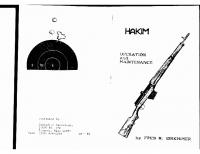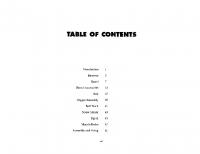The .50-Caliber Rifle Construction Manual: With Easy-to-Follow Full-Scale Drawings 1581603460, 9781581603460
This is the book that do-it-yourselfers anxious to try building their own .50-caliber rifles have been demanding since t
132 86 4MB
English Pages 65 Year 2002
Recommend Papers
File loading please wait...
Citation preview
we
“THE .50-CALIBER. RIFLE. MANUALS
, (OLLOW FULL-SCA
f
3 7 13 17
29 4] 43 43 47
61
Receiver Barrel Barrel Accessories Bolt
Trigger Assembly Butt Stock Scope Mount Bipod Muzzle Brake
Assembly and Firing
Vii
1
OF CONTENTS
Introduction
TABLE
INTRODUCTION
Some time ago when Paladin and I made The Home Workshop
rifle is its greater range. As long as a suitable backstop is used
.50-Caliber Sniper Rifle video, we opened a can of worms that nei-
and the shooter knows where the bullet is going, even this
ther of us had anticipated. This video was never intended as a construction guide whereby one could simply look at it and build a gun; rather it was simply to show methods used to fabricate the
complaint is nullified.
As of this writing it is legal to build such a gun for one’s own use, provided the maker’s name and address and a serial number
ally expect to build such a gun simply from a video. However, shortly after the video was released both Paladin and
are stamped on the receiver. Keep your eyes and ears open on this though. There has already been at least one bill introduced in the U.S. Congress trying to make .50-caliber rifles illegal. This bill did-
I were deluged with requests, even demands, for a set of drawings
n't get anywhere, but rest assured there will be more attempts.
and dimensions to allow the building of such a gun. I began the
Sooner or later the politicians will sneak a bill through to outlaw the .50-caliber rifle—and they probably won’t even tell us about it until they come to seize the weapons. So stay alert. Please remember that since we have no control over the materials or workmanship used in the project, neither Paladin nor I can accept any responsibility whatever regarding the safety or condition of a gun that someone else makes. However, if proper materi-
component parts. It never occurred to me that anyone would actu-
project, but since I am now 72 years old, almost blind, and afflicted with Parkinson’s disease, my work went rather slowly. But here
it is, finally, and I apologize for any distress or problems the delay
may have caused anyone. Many people seem to feel that the .50 is an awesome small cannon that is dangerous to shoot and only good for criminal operation. In truth, this gun, just like any other, is no more
dangerous
than the person shooting it, and if any serious
crimes have been committed with one, the news has been kept
awfully quiet. I have never heard of an incidence. Actually, the only thing more dangerous about a .50-caliber than any other
als are used and heat-treated correctly, a decent chamber is cut, and
the firing your gun It is Workshop
pin is set at the right protrusion, there is no reason why should not be safe to shoot. Mine is. recommended that you obtain a copy of The Home .50-Caliber Sniper Rifle video before you attempt to build
THE .50-CALIBER RIFLE CONSTRUCTION
MANUAL
one of these rifles. It may clarify some of the methods used that I failed to describe clearly.
The .50-caliber rifle is an effective and safe firearm with many uses.
RECEIVE
The receiver body is made from a 36-inch length of 2 1/4-inch-
diameter (2.250-inch) seamless 4130 tubing with a .120-inch wall thickness. It has an inside diameter of 2.010 inches, which gives
.010 inch of clearance over a 2-inch-diameter bolt body. This allows the bolt to reciprocate freely, without binding. Both ends of the tubing must be squared and perpendicular to the length. Unless a lathe with a hole through the headstock spindle that will accept this large-diameter tubing is available, you will likely have to use the milling machine to accomplish this. You must square the ends because unsquare ends will cause the rifle to fire groups erratically. Most measurements shown in the drawwings were made using the forward end as the starting point. A line should be marked along the exact top and bottom sides to measure from. On the guns I have built, [ used six rows of oblong openings spaced equidis-
tantly around the forward portion. These actually serve no good purpose except maybe to cool the barrel slightly, but they do improve its looks somewhat. These openings can be positioned however you wish or can be eliminated entirely with no ill effect. The ejection port should now be cu t to siz yas weil as the sear opening, and six rows of two each 1/4-inch (50-inch) holes are drilled as indicated. The barrel-retaining sleeve, which secures and
supports the rear end of the barrel, is positioned and welded in place through these holes by what is known as rosette welding. This part, however, should not be welded in place until the barrel,
bolt, and barrel extension are completed. w comes the fun part: cutting the bolt slot. If two vises are available, both should be used, one near each end of the cut. A fairclose-fitting piece of round stock should be placed inside to pre-
vent the tube from collapsing when the slot is cut, and the cut should be stopped just before it cuts through at the rear. This tubing has a tendency to spring open when cut all the way to the end. It should have the two screws in place through the buttstock extenbefore the entire cut is made. The narrow section between the back end of the loading / ejection port and the bolt slot should be included just to keep the receiver tube from spreading open slightly at this point. trigger and sear base are now welded, or silver-soldered,
in place, and this part is laid aside until the rest of the receiver components are fabricated (along with the barrel and bolt) and fitted and assembled.
Note that the receiver drawing (enclosed as a separate foldout) shows the receiver at full size.
THE
.SO-CALIBER
RIFLE
CONSTRUCTION
Barrel and receiver.
Front end of receiver.
MANUAL
RECEIVER
Receiver, showing ejection port.
Trigger mounting bracket and middle threaded section for barrel-retaining nut.
THE
.50-CALIBER
RIFLE
CONSTRUCTION
MANUAL
Barrel threads for retaining nut and muzzle brake.
Breech end of barrel with locking lug section in place.
WOLLOd Y3AIS93u
MalA dvd
dais LHDSIY »
cur
«OSS'S
~
y
20.750”
13,375
700"
we | RIGHT SIDE
9
.250” Dia. u
.750”
5.750"
RECEIVER BOTTOM
4.875”
4,250”
.250” Dia.
4.875”
t
6 ROWS OF TWO EACH
RIGHT SIDE
RECEIVER BOTTOM
:
WOLLOd
-
|
|
fy
Y3AIR934
Jats LHDIY
«O0SZ'01
4
1
|
Kb tL
nll










